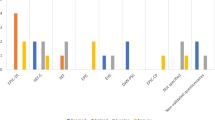Abstract
Purpose: To assess fecal incontinence rates and bowel function for radical perineal (RPP) or radical retropubic (RRP) prostatectomy patients and to compare them with a matched control group.
Methods: The bowel function domain of the Expanded Prostate Cancer Index Composite (EPIC) was mailed to 150 consecutive patients who had undergone RPP (79) or RRP (71) by the same surgeon (HJK) and an age-matched control group (75).
Results: Fecal incontinence and bowel dysfunction were statistically equivalent for the study groups.
Conclusions: There is no difference in fecal incontinence rates or bowel function when comparing RPP patients to RRP or control patients.
This is a preview of subscription content, access via your institution
Access options
Subscribe to this journal
Receive 4 print issues and online access
$259.00 per year
only $64.75 per issue
Buy this article
- Purchase on Springer Link
- Instant access to full article PDF
Prices may be subject to local taxes which are calculated during checkout
Similar content being viewed by others
References
Wei JT et al. Development and validation of the expanded prostate cancer index composite (EPIC) for comprehensive assessment of health related quality of life in men with prostate cancer. Urology 2000; 56: 899–905.
Korman HJ, Leu PB, Goldstein NS, Huang R . A centralized comparison of radical perineal and retropubic prostatectomy specimens: is there a difference with surgical approach? J Urol 2002; 168: 991–994.
Korman HJ, Harris MJ . Prostate cancer: radical perineal prostatectomy. eMedicine Journal, [serial online]. 2004; Available at: http://www.emedicine.com/med/topic3053.htm.
Bishoff JT et al. Incidence of fecal and urinary incontinence following radical perineal and retropubic prostatectomy in a national population. J Urol 1998; 160: 454–458.
Daum P et al. A longitudinal assessment of bowel related symptoms and fecal incontinence following radical perineal prostatectomy. J Urol 2003; 169: 2220–2224.
Walsh PC, Lepor H, Eggleston JD . Radical prostatectomy with preservation of sexual function: anatomical and pathological considerations. Prostate 1983; 4: 473–485.
Nelson R, Norton N, Cautley E, Furner S . Community-based prevalence of anal incontinence. JAMA 1995; 274: 559–561.
O'Keefe EA, Talley NJ, Tangalos EG, Zinsmeister AR . A bowel symptom questionnaire for the elderly. J Gerontol 1992; 47: M116–M121.
Steineck G et al. Scandinavian prostatic cancer study group number 4: quality of life after radical prostatectomy or watchful waiting. N Engl J Med 2002; 347: 790–796.
Author information
Authors and Affiliations
Corresponding author
Rights and permissions
About this article
Cite this article
Korman, H., Mulholland, T. & Huang, R. Preservation of fecal continence and bowel function after radical perineal and retropubic prostatectomy: a questionnaire-based outcomes study. Prostate Cancer Prostatic Dis 7, 249–252 (2004). https://doi.org/10.1038/sj.pcan.4500723
Received:
Revised:
Accepted:
Published:
Issue Date:
DOI: https://doi.org/10.1038/sj.pcan.4500723



